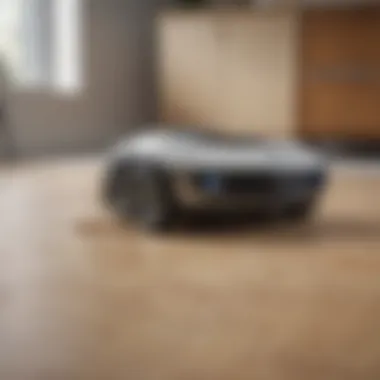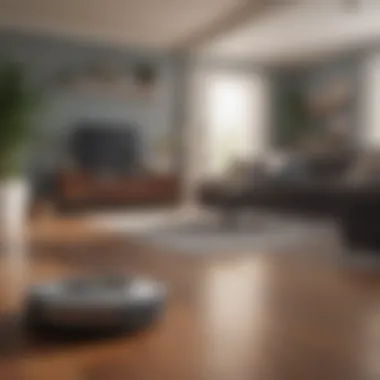The Evolution and Impact of Shark Robots in Home Cleaning


Intro
In recent years, the landscape of home cleaning has undergone a significant transformation, largely due to advancements in robotic vacuum technology. The introduction of smart robots, such as Shark robots and Roomba models, has reshaped how we maintain cleanliness in our living spaces. This analysis offers a focused exploration of these innovations, particularly Shark's unique contributions. By evaluating their design, functionality, and user experience, we can understand their impact on modern home management.
Design Inspiration
The aesthetics of robotic vacuums plays an important role in consumer choices. Both Shark and Roomba have embraced contemporary designs appealing to today's homeowners. Recent trends highlight sleek lines and modern finishes, blending seamlessly into various home decors.
- Trending Styles: Not only do these devices offer functionality, but their appearance is also well thought out. Consumers are drawn to designs that exhibit elegance and innovation, creating an appealing addition to home environments.
- Color Palettes: Manufacturers have expanded color options beyond traditional blacks and grays. Bright colors and unique patterns enhance devices' visibility while capturing the attention of potential buyers.
These design elements are not mere afterthoughts; they resonate with consumers looking to enhance their living spaces with practical yet stylish technology.
Practical Tips
Understanding the practical aspects of owning a robotic vacuum can greatly enhance user experience. Proper care and planning are essential for maximizing the potential of these devices.
- Maintenance & Care: Regular maintenance ensures optimal performance. Users should clean filters and brushes frequently to prevent clogging. This can prolong the life of the device while maintaining its efficiency.
- Budgeting & Planning: Investing in a Shark or Roomba robot requires thoughtful budgeting. Homeowners should consider not only the upfront cost but also any recurring expenses, such as replacement parts and maintenance supplies.
Preface to Robotic Vacuum Cleaners
Robotic vacuum cleaners have transformed the landscape of home cleaning technology. These devices have made significant advancements since their introduction, enhancing convenience and efficiency for homeowners. Understanding their rise in popularity is vital; it reflects changing lifestyles and the increasing need for innovative solutions in household management.
The core appeal of robotic vacuums lies in their automation capabilities. Unlike traditional cleaners, these robots operate independently, requiring minimal user input. This convenience allows individuals to allocate their time to more significant tasks or leisure activities while maintaining a clean living environment. In addition, robotic vacuums can navigate various surfaces, adapting their cleaning paths according to the room's layout, which further increases their utility.
Key Benefits of Robotic Vacuum Cleaners:
- Time Efficiency: They can perform cleaning routines without direct supervision.
- User-Friendly Technology: Many models feature smartphone integration, allowing users to control them remotely.
- Physical Ease: Reducing manual effort makes cleaning less strenuous for all age groups.
However, there are also considerations surrounding their efficacy. Users must be aware of their limitations, such as battery life, debris capacity, and potential navigation issues in complex spaces. Additionally, the upfront cost can deter some consumers, even though many view it as an investment in convenience and smart home technology.
Understanding these facets of robotic vacuum technology prepares homeowners to make informed decisions about their cleaning options. The evolution of this technology, particularly in relation to brands like Shark and Roomba, underscores significant engineering advancements that have shaped the products available today. Compiling insights into their functionality is crucial as modern households increasingly integrate smart technology into their daily lives.
"The increasing reliance on robotic devices marks a fundamental shift in household management and modernization of daily chores."
In this article, we will explore these dynamics deeply, focusing on the advancements and the impact of Shark robots in contrast with Roomba technology.
Overview of Shark Robots
Shark robots have made a significant mark in the landscape of home cleaning technology. These devices combine advanced engineering with user-centric design. When homeowners consider purchasing a robotic vacuum, understanding the capabilities of Shark robots compared to others, like Roomba, is crucial. This overview highlights the foundational aspects of Shark robots, focusing on their technology and the specific features that set them apart.
Foundational Technology
At the core of Shark robots lies a sophisticated array of sensors and algorithms. These assist in mapping and navigating the home efficiently. The development of LiDAR and camera-based technologies allows for better spatial awareness. The robots create a virtual map of the home. This technology enables navigation through different rooms without getting stuck or repeating areas unnecessarily. Indeed, the foundational technology of Shark robots centers around precision and adaptability, enhancing the cleaning experience and offering a significant advantage in terms of coverage.
Additionally, Shark robots employ a unique cleaning system that differs from traditional suction methods. They include self-cleaning brush rolls that minimize hair wrap and improve performance. This feature is particularly beneficial for homes with pets, where hair can become an impediment for other models. The efficiency of the cleaning system adapts to various surface types—carpets, hardwood, and tiles—ensuring thorough cleaning regardless of the environment.
Key Features and Specialization
Shark robots present several distinctive features catering to the needs of diverse households. One standout feature is the variable suction control, allowing users to adjust power according to cleaning requirements. This flexibility in settings is designed specifically to accommodate both delicate areas requiring gentle cleaning and heavily soiled spots needing more strength.
The Shark IQ Robot, for instance, offers a self-emptying base that eliminates frequent cleaning interruptions. This autonomy is appealing to busy homeowners who prefer low maintenance. The integrated voice control capabilities through smart assistants like Amazon Alexa and Google Assistant significantly enhance user experience, facilitating hands-free operation.
Shark robots are also equipped with advanced filtering systems, capturing allergens and pollutants. This aspect is vital for households with allergy sufferers. By reducing particles in the air while cleaning, these robots contribute not just to cleaner floors but also to improved air quality.


Overall, the evolution of Shark robots emphasizes user-friendly technology and specialized features tailored to meet the modern homeowner's needs. Exploring their foundational technology and key features illustrates why these devices remain a popular choice in robotic cleaning.
Understanding Roomba Innovations
The Roomba has fundamentally changed the way people approach home cleaning. It is not just another gadget; it’s a revolution in household management. Understanding Roomba innovations provides insights into the technological advancements that directly affect user efficiency and satisfaction. These innovations are critical for homeowners, interior design enthusiasts, and various users who prioritize cleanliness while maintaining a modern lifestyle.
One important aspect of Roomba technology is its automation features. The self-navigation capability allows these devices to move around obstacles, ensuring that every corner of a room can be accessed. This automation reduces the physical effort that users traditionally must invest in home cleaning. It promotes a more efficient cleaning routine, leaving users with extra time for other activities.
Historical Context and Development
The history of Roomba began in 2002 when iRobot introduced the first model. This early version set the foundation for future innovations. While using simple algorithms to navigate, it was limited in its cleaning capacity. Gradually, through enhancements in computational power and sensor technology, Roomba has evolved significantly.
In 2004, a new model featured improved suction power and a better battery life, which addressed some complaints from initial users. The introduction of the Roomba 400 series brought along more intuitive cleaning schedules, allowing owners to program cleanings while at work. Each new version focused on enhancing user experience based on market feedback.
Evolution of Technology
The evolution of Roomba technology is characterized by continual improvements in mechanical design and software capabilities. Early Roombas relied mainly on random movement patterns, which proved effective yet inefficient in cleaning larger spaces. Recent models, however, incorporate advanced mapping technologies. For instance, iRobot’s use of simultaneous localization and mapping has made it possible for Roombas to memorize home layouts, enabling a systematic cleaning route.
Moreover, the integration of smart home compatibility features turns Roomba into an essential part of a connected home. Users can control their Roomba via smartphone applications or voice commands through platforms like Amazon Alexa. This integration is significant as it marks a shift from traditional manual control to a more interactive and user-friendly experience. As technology continues to evolve, Roomba remains at the forefront, ensuring that it adapts to the changing needs of its users.
"Understanding the progress of Roomba technology reveals a commitment to efficiency and user satisfaction, marking its importance in modern cleaning solutions."
Comparative Analysis of Shark and Roomba
The comparative analysis between Shark robots and Roomba vacuums serves as a critical exploration of their respective technologies and user efficiencies. In a market saturated with robotic vacuum options, examining the contrast in performance, user experience, and design aesthetics becomes paramount. Homeowners seeking to enhance their cleaning routines must understand how each model excels or falters in these areas. This section aims to illuminate the strengths and weaknesses of Shark and Roomba, providing insights that can guide consumers in their purchasing decisions.
Performance Metrics
Performance metrics are essential to quantify the effectiveness of cleaning robots. When comparing Shark robots to Roomba models, several factors come into play, such as suction power, navigation capabilities, and battery life. Shark robots are often lauded for their robust suction power, which aids in capturing pet hair and larger debris. Additionally, models like the Shark IQ Robot incorporate self-emptying bins, streamlining the cleaning process significantly.
On the other hand, Roomba models, particularly the i7 and s9 series, are known for their intelligent mapping technologies. These vacuums utilize advanced sensors to optimize their cleaning paths, ensuring that every corner receives attention. Battery efficiency also varies; while some Roomba models offer impressive run times, Shark vacuums tend to recharge and continue cleaning with minimal interruption.
The decision largely depends on individual cleaning needs. A home with pets may benefit from the strong suction of Shark, whereas a user focused on high-tech navigation might prefer Roomba's intuitive mapping.
User Experience
User experience encompasses more than just performance; it includes how users interact with their robotic vacuums. Here, Shark and Roomba offer distinct experiences. Shark robots typically provide straightforward interfaces, making them easier to operate for users who prefer simplicity. The basic app functionalities allow users to schedule cleaning sessions without overwhelming them with features.
Conversely, Roomba's user experience is enhanced by its advanced app integration. The iRobot Home app allows users to customize cleaning schedules, create designated no-go zones, and even control the vacuum remotely. This level of control appeals to homeowners who appreciate technology that adapts to their lifestyles.
Feedback from users often highlights the ease of maintenance in both brands. Shark's self-cleaning features reduce the need for frequent hands-on cleaning, while Roomba provides alerts for maintenance needs through its app. Each brand has its loyal consumers, demonstrating that user experience can significantly influence brand preference.
Design and Aesthetics
Design and aesthetics play crucial roles in how robotic vacuums are perceived in home environments. Shark robots are typically designed with a sleek, functional look, often blending seamlessly with modern interior designs. Their lower profiles make it easy for them to navigate under furniture, an important consideration for many consumers.
In contrast, Roomba models often feature a classic round design that is immediately recognizable. While their aesthetics may seem simpler, they capitalize on a functional approach. Many users find value in the availability of various colors and styles in Roomba’s lineup, allowing for personal expression through choice.
In terms of build quality, both brands exhibit durability, yet Shark’s construction tends to prioritize ruggedness, particularly for pet-friendly homes. This durability could matter in choosing a vacuum that withstands daily use.
Ultimately, the choice between Shark and Roomba may come down to personal taste. Each user will weigh both functionality and design differently based on their lifestyle and home decor.
"Understanding the core differences between Shark and Roomba can empower homeowners to make informed decisions about their cleaning technology needs."
Both brands have established themselves as leaders in the robotic vacuum market, and knowing the comparative advantages can simplify the decision-making process.


Practical Applications in Home Cleaning
Understanding the practical applications of Shark robots in home cleaning is essential for homeowners looking to streamline their cleaning routines. These advanced robotic vacuums are designed to integrate seamlessly into daily life, providing a solution that can simplify chores and enhance living spaces. The impact they have on efficiency, effectiveness, and overall user experience cannot be overstated.
Daily Maintenance and Cleaning Routines
Daily maintenance is a crucial function of robotic vacuums like Shark robots. Their design allows for systematic cleaning without the constant need for human intervention. Users can schedule cleaning sessions according to their preferences, ensuring that their living areas remain clean with minimal effort.
With models such as the Shark IQ Robot, homeowners can benefit from advanced mapping technology. This feature allows the device to remember the layout of the house, optimizing cleaning paths. Notably, these robots can also detect areas that require more attention, thanks to their sensors. This means they can adapt their cleaning routine based on the specific needs of each session, be it high traffic areas or pet spots. Consequently, routines become more efficient, leading to cleaner homes.
Another aspect to consider is the convenience of automation. Shark robots can operate unattended and resume cleaning after charging, which enhances their practical value. Users can focus on other tasks while the robot handles the chore of keeping floors clean. This automation saves time, allowing residents to engage in more productive activities, which ultimately enriches their daily life.
Adaptability to Home Environments
Adaptability is a defining characteristic of modern robotic vacuums, including Shark models. These machines are built to handle a variety of surfaces, from carpets to hardwood floors. Their technology allows them to switch modes, adjusting suction power as needed. This flexibility ensures they provide effective cleaning regardless of the surface type in a home.
In addition, these robots navigate obstacles with ease. They are equipped with sensors that prevent them from falling down stairs or getting stuck under furniture. This capability is particularly beneficial in homes filled with furniture or elaborate layouts. For instance, the Shark AI Robot uses advanced perception technology to traverse complex environments, thereby minimizing the risks associated with robotic cleaning.
Furthermore, Shark robots have been engineered to be user-friendly. They often come with mobile apps that allow users to control and monitor cleaning sessions remotely. This feature means homeowners can customize cleaning schedules based on their unique home environments or personal preferences, thereby maximizing the device’s utility.
To summarize, the practical applications of Shark robots in home cleaning are significant. Their capabilities in daily maintenance and adaptability to diverse home environments underscore their role in modern cleaning solutions. The time saved and the efficiency gained through these devices make them a valuable addition to any household.
Environmental Considerations
In the discussion of robotic vacuums, especially Shark robots and Roomba, it is essential to examine environmental considerations. These devices represent a significant shift in how we approach home cleaning. The importance of sustainability in product design becomes increasingly relevant as awareness of ecological issues grows. Homeowners are looking for efficient cleaning solutions that also minimize their impact on the environment.
Energy Efficiency of Robotic Vacuums
Energy efficiency in robotic vacuums is a major factor influencing consumer choices. Shark robots and Roomba models are designed to operate with energy conservation in mind. These devices typically use less energy than traditional vacuum cleaners, making them an attractive option for the environmentally conscious homeowner.
- Smart Navigation: Both Shark robots and Roomba models use advanced navigation systems that allow them to map out a space. This capability enables them to clean efficiently without wasting power. For instance, models with dirt detect technology can focus energy where it is needed most, optimizing cleaning performance.
- Battery Life: The battery systems in these vacuums have also evolved. High-capacity lithium-ion batteries enable longer cleaning cycles with less frequent charging required. The efficiency in power usage translates to less electricity consumption overall.
Choosing an energy-efficient vacuum cleaner will not only save money on utility bills but also contribute to an overall reduction in greenhouse gas emissions.
Recycling and Waste Management
Recycling and waste management are crucial elements of environmental considerations. Robotic vacuum cleaners, like Shark and Roomba, integrate this aspect into their design philosophy more than ever. As homeowners embrace eco-friendly practices, the need for responsible disposal and recycling options becomes vital.
- Materials Used: Many modern robotic vacuums use recyclable materials in their construction. This helps minimize landfill waste when the device reaches the end of its lifecycle. For example, components like plastic can often be recycled, promoting a circular economy.
- Filter Replacement: Regular maintenance, such as filter changes, poses another opportunity for sustainable practices. Brands often offer recycling programs for used filters and parts, encouraging consumers to return these items for proper recycling instead of tossing them in the trash.
- End-of-Life Strategies: Companies are becoming more aware of the environmental impact of their products. Many Shark and Roomba models come with guidelines about proper disposal and recycling options. By following these guidelines, consumers can ensure that their vacuums are disposed of responsibly.
"By prioritizing energy efficiency and responsible waste management, homeowners can play a role in reducing their ecological footprint while benefiting from advanced cleaning technologies."
Maintenance and Repair of Shark and Roomba
Understanding the maintenance and repair of Shark and Roomba robotic vacuum cleaners is essential for homeowners who rely on these devices for efficient cleaning. Regular upkeep ensures that the robots perform at their best while also extending their lifespan. Both Shark and Roomba cleaners carry unique features and technological innovations. However, similar principles of maintenance and repair apply to both brands, helping users minimize downtime and enhance cleaning efficiency. Over time, knowledge of common issues can lead to more effective problem-solving and improved user experience.
Routine Maintenance Tasks
Routine maintenance is a cornerstone of keeping either a Shark or Roomba robot running smoothly. Here are some essential tasks:
- Cleaning the Brushes: Hair and debris often get tangled in the brushes. Regularly detangling and cleaning these brushes will maintain optimal performance.
- Emptying the Dustbin: Both types of machines require periodic emptying of their dustbins. This prevents clogs and ensures effectiveness in collecting dirt.
- Checking and Replacing Filter: Filters can get dirty and diminish suction power. Checking every few weeks and replacing them as needed is vital.
- Charging the Battery: Keeping the battery charged is important for performance. Over time, roomba batteries may lose capacity, thus requiring eventual replacement.
These tasks may seem straightforward, but they significantly impact the long-term functionality of the robotic vacuum cleaner.
Common Repair Issues and Solutions


Like any technology, Shark and Roomba robotic vacuums may encounter issues requiring attention. Here are some common problems and potential solutions:
- Loss of Suction Power:
- Navigation Problems:
- Failure to Charge:
- Inconsistent Connectivity:
- Solution: Clean the filters and empty the dustbin. If issues persist, check for clogs in the hoses or vacuum paths.
- Solution: Ensure that sensors are clean and unobstructed. If the issue continues, resetting the device might help.
- Solution: Inspect the charging dock and pins for any dirt or obstruction and ensure a proper connection. Sometimes, replacing the charging cable and battery can resolve the issue.
- Solution: For models with app features, ensure the Wi-Fi connection is stable. Resetting both the vacuum and the router may help.
By addressing these common issues promptly and effectively, users can ensure a longer lifespan for their Shark or Roomba devices, making them an invaluable asset in modern home cleaning.
The Future of Robotic Vacuum Technology
The evolution of robotic vacuum technology stands at a pivotal junction, predicting transformative changes for both home cleaning and smart home integration. As the market for vacuum robots expands, understanding upcoming trends and innovations is crucial. These developments will not only enhance cleaning efficiency but also adapt more seamlessly into our daily lives. Homeowners need to consider how these advancements may influence their cleaning routines and the overall management of their living spaces.
Emerging Technologies and Trends
Several trends are reshaping the landscape of robotic vacuum cleaners. The first is artificial intelligence. Next-generation Shark robots and Roomba models are integrating AI to enhance navigation and obstacle detection. By utilizing machine learning algorithms, these devices can identify specific areas needing attention. This capability improves the overall cleaning experience by optimizing paths and reducing missed spots.
In addition, Lidar technology is increasingly being used in vacuum robots. This technology allows for precise mapping of home layouts, enabling robots to create effective cleaning strategies. Furthermore, advances in battery life mean longer cleaning sessions without the need for frequent recharges.
- Key Innovations:
- Artificial intelligence for better navigation.
- Lidar for detailed home mapping.
- Improved battery efficiency for extended use.
Integration with Smart Home Systems
The future of robotic vacuums also rests on their integration into smart home ecosystems. As homeowners adopt more smart devices, having a robotic vacuum that connects seamlessly with systems like Amazon Alexa or Google Home enhances convenience.
This integration allows for real-time control through voice commands. Users can schedule cleaning sessions, check battery status, or even override cleaning paths with simple instructions.
- Benefits of Integration:
- Streamlined user experience with voice commands.
- Increased versatility in scheduling and monitoring.
- Enhanced home automation through interconnected devices.
"Integration with existing smart home systems will redefine how users interact with their cleaning devices, making them an integral part of home management."
Finale
The conclusion serves as a vital component of this article. It brings together the various threads of discussion, emphasizing the evolution and impact of robotic vacuum technology, specifically comparing Shark robots with Roomba models. This section encapsulates the insights gained throughout the analysis and demonstrates the significance of robotic vacuums in modern home management.
Summary of Key Findings
From the exploration of foundational technologies to practical applications, several key findings emerge. First, both Shark and Roomba robots have advanced significantly in their navigation, suction power, and cleaning efficiency. Shark robots often excel in picking up pet hair and navigating complex living spaces, while Roomba's sophisticated algorithms provide a thorough clean in various environments.
Additionally, the user experience surrounding these devices has transformed. Homeowners appreciate the convenience and time-saving aspects that these robots offer. With features like smartphone integration, scheduling, and smart home compatibility, robotic vacuums contribute positively to everyday life.
Environmental considerations also play a crucial role. As manufacturers prioritize energy-efficient designs, they help reduce the carbon footprint associated with home cleaning. Both Shark and Roomba models are noted for their energy-saving capabilities and responsible recycling strategies.
Final Thoughts on Robotic Vacuum Utilization
Looking toward the future, it is clear that robotic vacuums will continue to evolve. The integration of artificial intelligence and smart home technology suggests a trend towards more autonomous and efficient cleaning systems. Homeowners should remain informed about these advancements and consider how such technology fits into their lifestyles.
Robotic vacuum cleaners like Shark and Roomba not only simplify cleaning routines but also reflect broader changes in home automation trends. For individuals who prioritize convenience, both brands offer valuable options. Understanding their unique features and benefits can enhance decision-making, ensuring that each homeowner optimizes their cleaning experience.
"Robotic vacuum cleaners represent a shift in home maintenance, reflecting modern demands for efficiency and technology."
In summary, the impact of Shark and Roomba technologies in home cleaning is profound, promoting an easier, more efficient approach to managing household chores. As these technologies continue to advance, their role in home management will likely grow, influencing how we approach cleaning for years to come.















